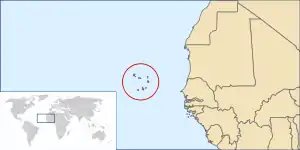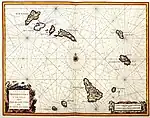Portuguese Cape Verde
Cape Verde was a colony of the Portuguese Empire from the initial settlement of the Cape Verde Islands in 1462 until the independence of Cape Verde in 1975.
Overseas Province of Cape Verde Província Ultramarina de Cabo Verde | |||||||||
|---|---|---|---|---|---|---|---|---|---|
| 1462–1975 | |||||||||
| Anthem: "Hymno Patriótico" (1808–26) Patriotic Anthem "Hino da Carta" (1826–1911) Hymn of the Charter "A Portuguesa" (1911–75) The Portuguese | |||||||||
 | |||||||||
| Status | Colony; Overseas province of the Portuguese Empire | ||||||||
| Capital | Praia | ||||||||
| Common languages | Portuguese | ||||||||
| Head of state | |||||||||
• 1462–1481 (first) | Afonso V | ||||||||
• 1974–1975 (last) | F. da Costa Gomes | ||||||||
| Governor | |||||||||
• 1588–1591 (first) | D. Lôbo da Gama | ||||||||
• 1974–1975 (last) | V. Almeida d'Eça | ||||||||
| Historical era | Imperialism | ||||||||
• Established | 1462 | ||||||||
• Negotiated decolonisation | 5 July 1975 | ||||||||
| Currency | Cape Verdean real (until 1914) Cape Verdean escudo (from 1914) | ||||||||
| ISO 3166 code | CV | ||||||||
| |||||||||
| Today part of | Cape Verde | ||||||||
| History of Cape Verde |
|---|
 |
| Colonial history |
| Independence struggle |
.svg.png.webp)
History
15th century
The islands of Cape Verde was discovered in 1444 by Prince Henry the Navigator (Son of King John I) and Antonio Noli in the service of Henrys relative King Afonso V. The southeastern islands, including the largest island Santiago, were discovered in 1460 by António de Noli and Diogo Gomes. The remaining northwestern islands São Nicolau, São Vicente and Santo Antão were discovered in 1461 or 1462 by Diogo Afonso.[1]: 73 There is no evidence of human settlement on Cape Verde prior to the arrival of the Portuguese.[1]: 77
In 1462, the town of Ribeira Grande (now Cidade Velha) was founded on the south coast of Santiago.[1]: 77 The settlement became a key port of call for Portuguese colonisation towards Africa and South America. In the 16th and 17th centuries, it was a centre of maritime trade between Africa, the Cape, Brazil and the Caribbean. Due to its proximity to the African coast, it was an essential platform for the trade of enslaved persons.[2] Other early Portuguese settlements were São Filipe on the island of Fogo (between 1470 and 1490),[3] Praia on Santiago (before 1516),[1]: 77 Ribeira Grande on Santo Antão (mid 16th century)[1]: 82 and Ribeira Brava on São Nicolau (1653).[4]
In 1492 the Spanish Inquisition emerged in its fullest expression of anti-Semitism. It spread to neighboring Portugal where King João II and especially Manuel I in 1496, decided to exile thousands of Jews to São Tomé, Príncipe, and Cape Verde. They were allowed to engage in trade. Free-lance traders were referred to as lançados, who were often, but not always, of Jewish origin.[5]
16th—19th centuries
The riches of Ribeira Grande and conflicts between Portugal and rival colonial powers France and Britain attracted pirate attacks, including those by Francis Drake (1585) and Jacques Cassard (1712).[1]: 195 Despite the construction of Forte Real de São Filipe in 1587-93, Ribeira Grande remained vulnerable and went into decline. The capital was moved to Praia in 1770.[6]
The eruption of the volcano Pico do Fogo in 1680 covered much of the island of Fogo in ash, which forced many inhabitants to flee to the nearby island of Brava.[7] From the end of the 18th century, whaling ships from North America started hunting whales around the Azores and the Cape Verde Islands. They used the harbours of Brava to stock up on supplies and drinking water. They hired men from Brava as sailors, and several of these settled around the Massachusetts whaling port of New Bedford.[1]: 439–440
The exploitation of salt on the island of Sal took a rise from around 1800.[8] The port city of Mindelo grew rapidly after 1838, when a coal depot was established to supply ships on Atlantic routes.[9] In the course of the 19th century, the Plateau of Praia was completely redeveloped with streets according to a grid plan, lined with grand colonial buildings and mansions.[6] Slavery was abolished in Cape Verde in 1876.[10]
20th century
From the beginning of the 20th century the port of Mindelo lost its importance for transatlantic navigation. Causes for this were the shift from coal to oil as fuel for ships, the rise of competing ports like Dakar and the Canary Islands and the lack of investment in port infrastructure.[9] Due to its generally dry climate, Cape Verde has been struck by a series of drought-related famines between the 1580s and the 1950s. Two of Cape Verde's worst-ever famines occurred in 1941–43 and 1947–48, killing an estimated 45,000 people.[11] Several thousands of islanders emigrated, for instance accepting contract labour on the cocoa plantations of Portuguese São Tomé and Príncipe.[12]
In the lead-up to and during the Portuguese Colonial War, those planning and fighting in the armed conflict in Portuguese Guinea often linked the goal of liberation of Guinea-Bissau to the goal of liberation in Cape Verde. For instance, in 1956, Amílcar and Luís Cabral founded the African Party for the Independence of Guinea and Cape Verde (PAIGC). However, there was no armed conflict in Cape Verde, and ultimately independence for Cape Verde resulted from negotiation with Portugal after the April 1974 Carnation Revolution.[13] In August 1974, an agreement was signed in Algiers between the Portuguese government and the PAIGC, recognising the independence of Guinea-Bissau and the right to independence of Cape Verde.[14] On 5 July 1975, at Praia, Portugal's Prime Minister Vasco Gonçalves turned over power to National Assembly President Abílio Duarte, and Cape Verde became independent.
Cape Verde Islanders had higher educational levels and were often appointed to low-level administrative posts in Portuguese territories. Thereby they acquired a reputation of loyalty to Lisbon.[15]
See also
- History of Cape Verde
- List of colonial governors of Cape Verde
- Arquivo Histórico Ultramarino (archives in Lisbon documenting Portuguese Empire, including Cape Verde)
References
- Valor simbólico do centro histórico da Praia, Lourenço Conceição Gomes, Universidade Portucalense, 2008
- "Cidade Velha, Historic Centre of Ribeira Grande - UNESCO World Heritage Centre". Retrieved 14 November 2018.
- Centre historique de São Filipe, UNESCO
- Inventário dos recursos turísticos do município de Ribeira Brava de São Nicolau, Direcção Geral do Turismo, p. 16
- Richard Lobban. "Jews in Cape Verde and on the Guinea Coast". Archived from the original on 25 August 2012.
- Centre historique de Praia, UNESCO
- S. F. Jenkins; et al. (20 March 2017). "Damage from lava flows: insights from the 2014–2015 eruption of Fogo, Cape Verde". Journal of Applied Volcanology. 6. doi:10.1186/s13617-017-0057-6.
- Ray Almeida. "A History of Ilha do Sal". Archived from the original on 6 February 2016.
- Génese e desenvolvimento da cidade do Mindelo: a preservação de uma identidade, Fred Yanick Fonseca Delgado, 2016, p. 76-80
- Lumumba H. Shabaka (2015). "Ending Slavery in Cabo Verde: Between Manumission and Emancipation, 1856-1876". Journal of Cape Verdean Studies. 2 (1): 109–132.
- Brooks, George E. (2006). "Cabo Verde: Gulag of the South Atlantic: Racism, Fishing Prohibitions, and Famines". History in Africa. 33: 101–135. doi:10.1353/hia.2006.0008. hdl:2022/3269. S2CID 162287310.
- Keese, Alexander (2012). "Managing the Prospect of Famine. Cape Verdean Officials, Subsistence Emergencies, and the Change of Elite Attitudes During Portugal's Late Colonial Phase, 1939-1961" (PDF). Itinerario. XXXVI (1): 49–69. doi:10.1017/S0165115312000368. S2CID 59064950.
- António Costa Pinto, "The transition to democracy and Portugal's decolonization", in Stewart Lloyd-Jones and António Costa Pinto (eds., 2003). The Last Empire: Thirty Years of Portuguese Decolonization (Intellect Books, ISBN 978-1-84150-109-3) pp. 22–24.
- Acordo entre o governo Português e o Partido Africano da Independência da Guiné e Cabo Verde, Centro de Documentação 25 de Abril
- Alexander Keese, "The role of Cape Verdeans in war mobilization and war prevention in Portugal's African empire, 1955-1965." International journal of African historical studies 40.3 (2007): 497-511 online.

.svg.png.webp)
